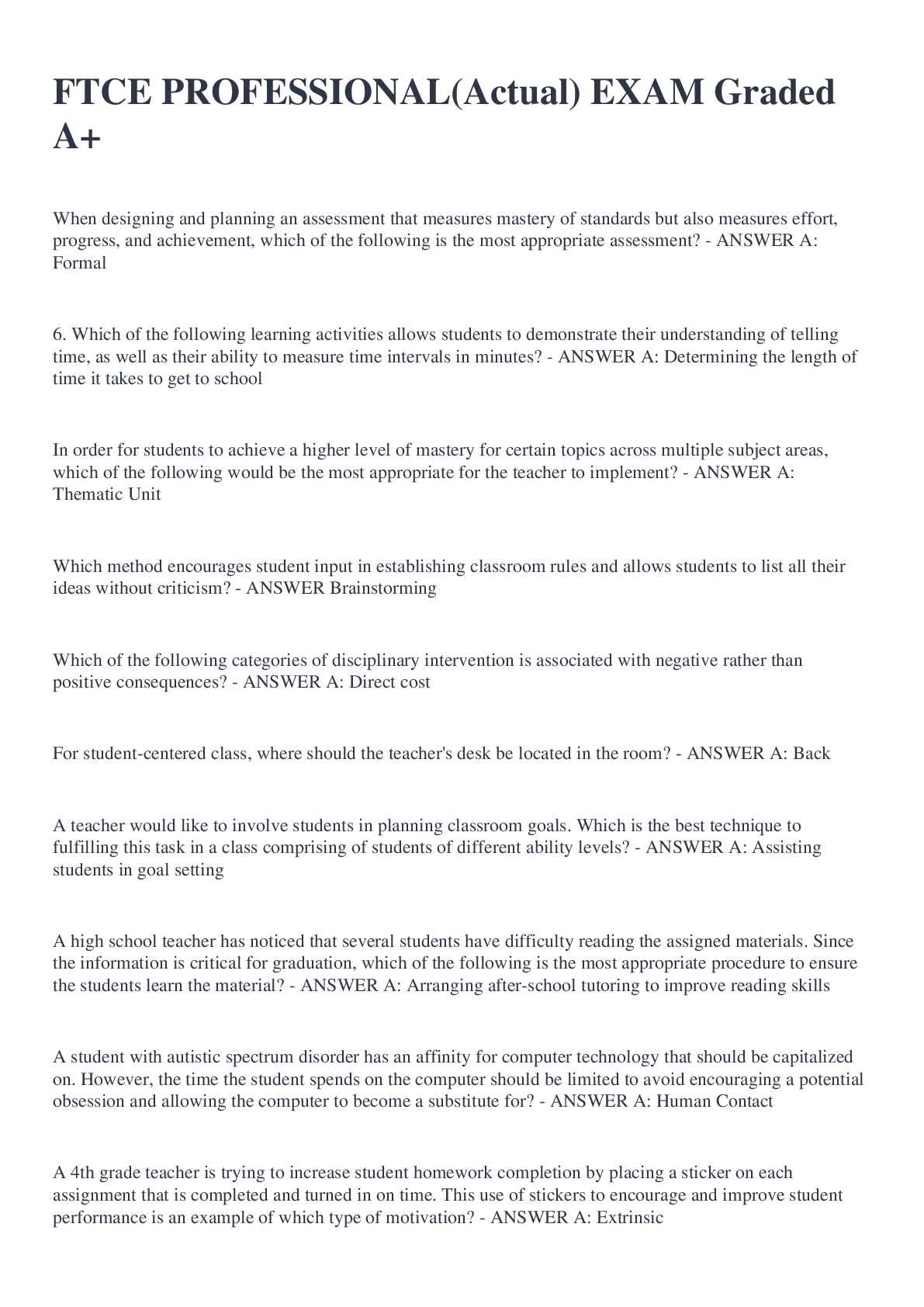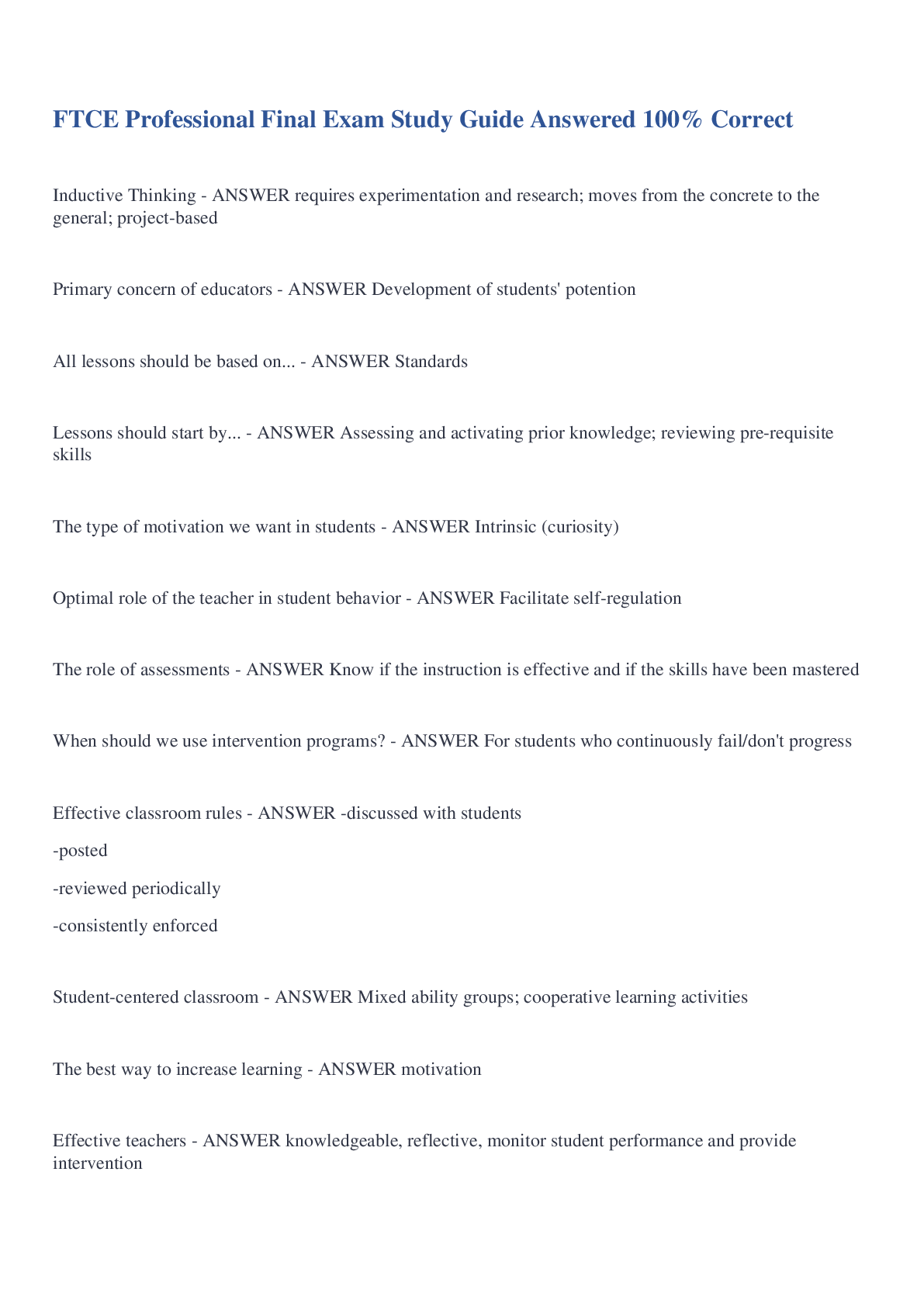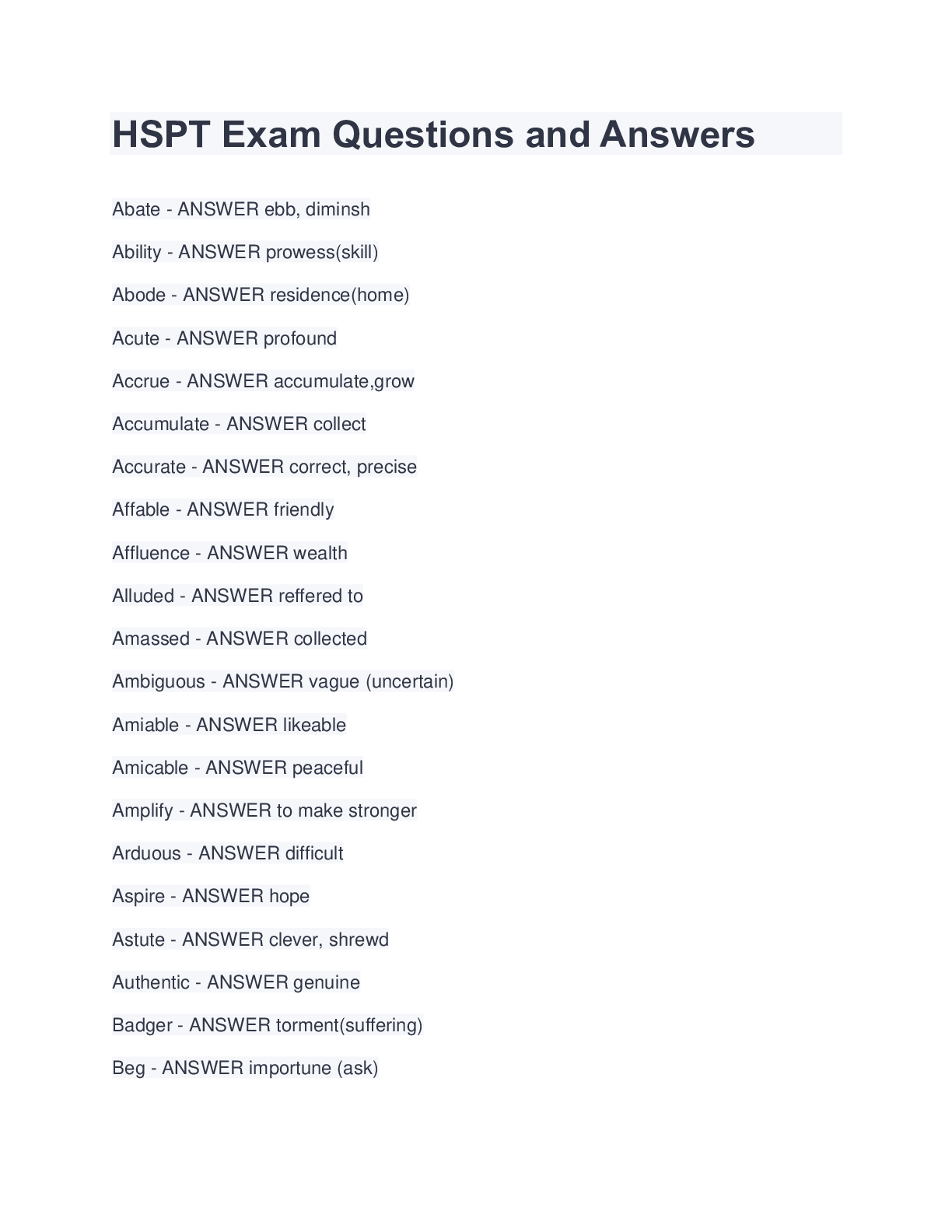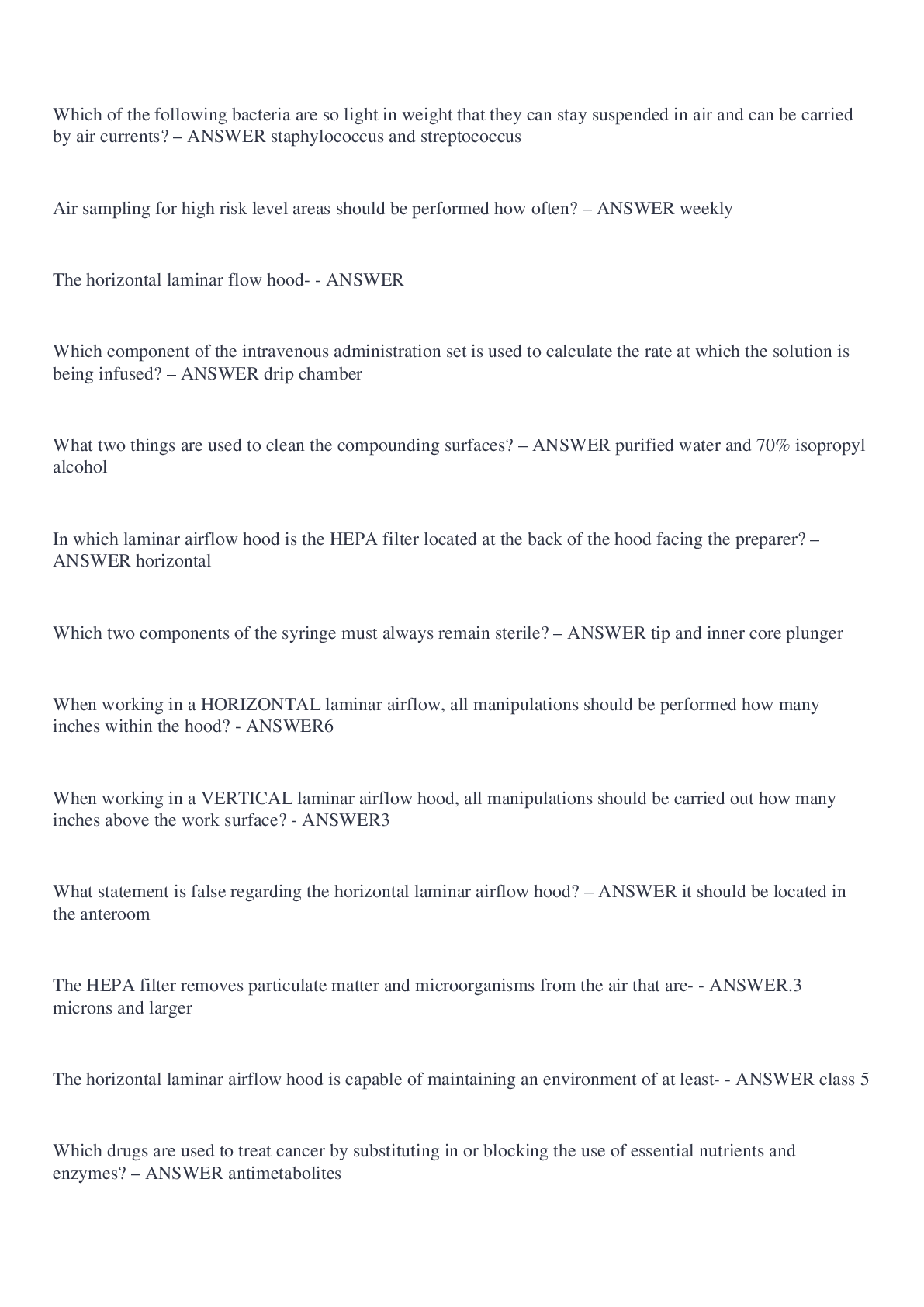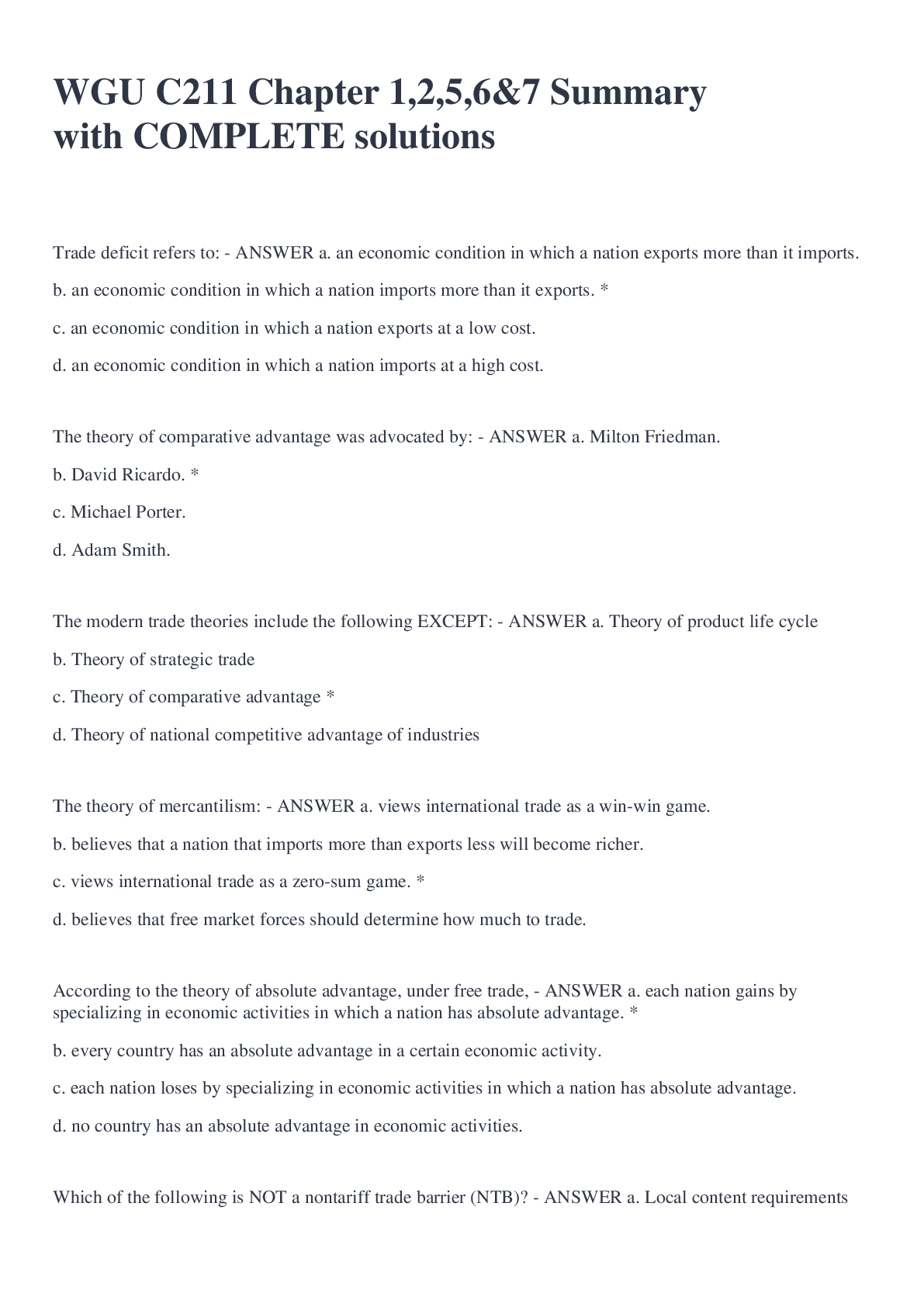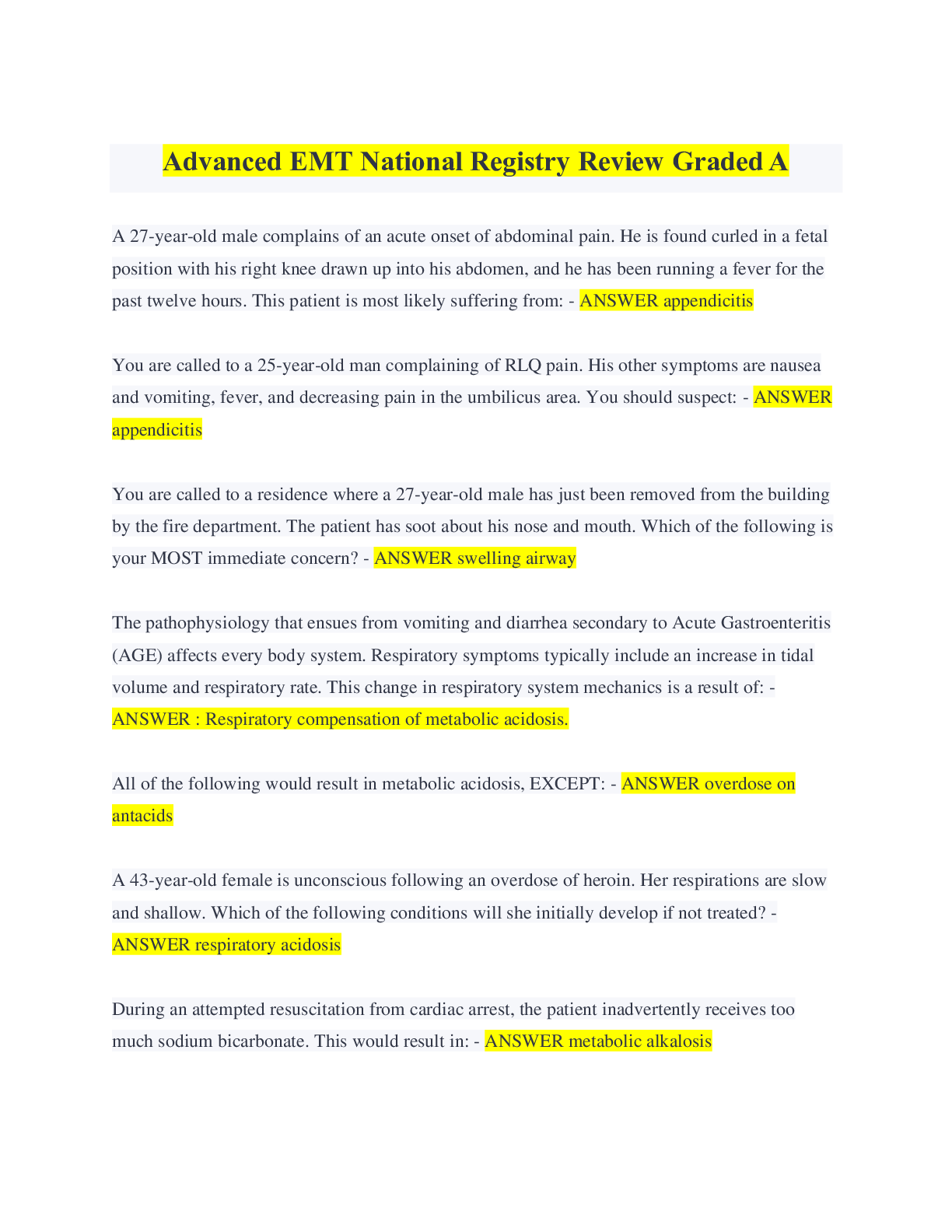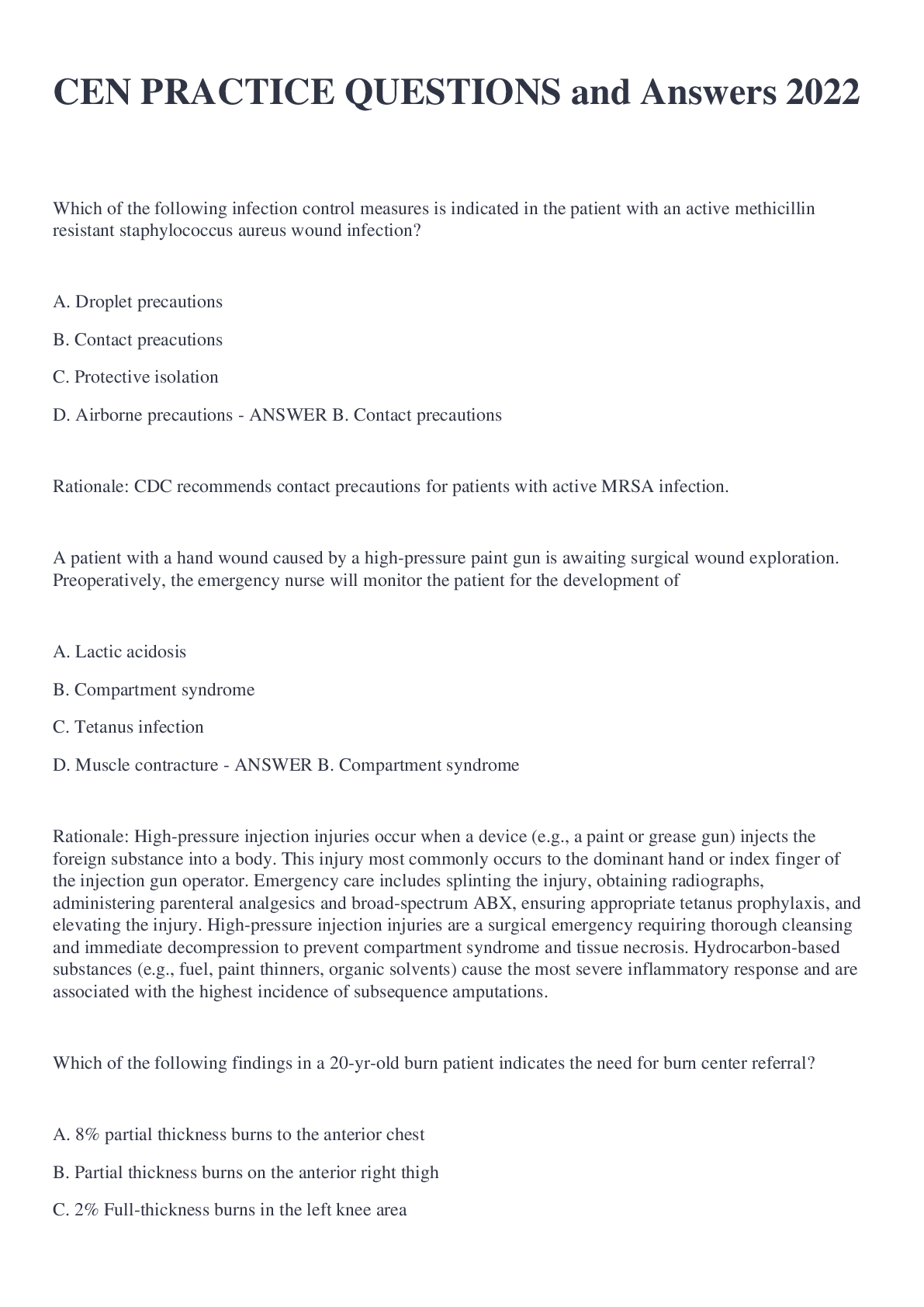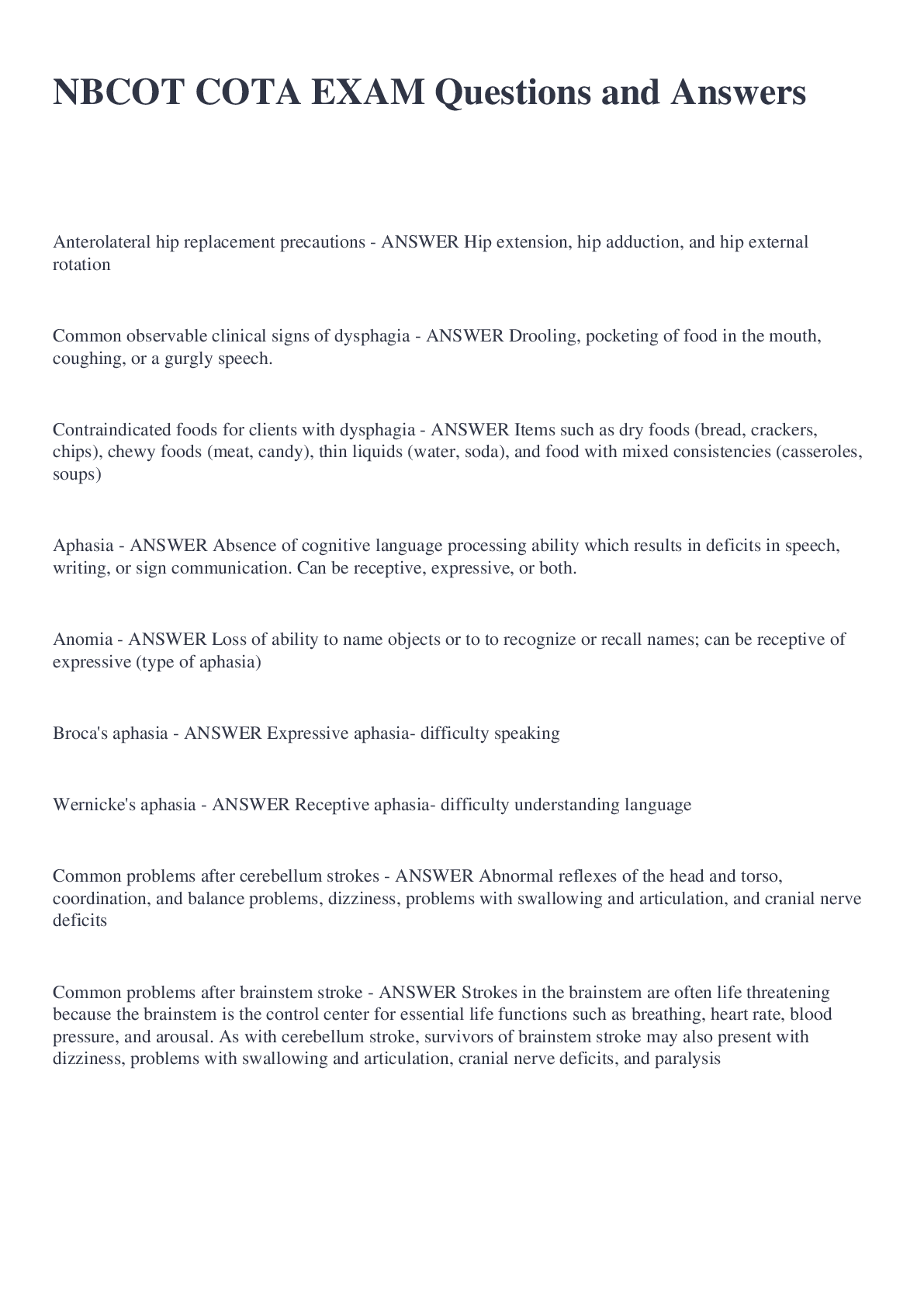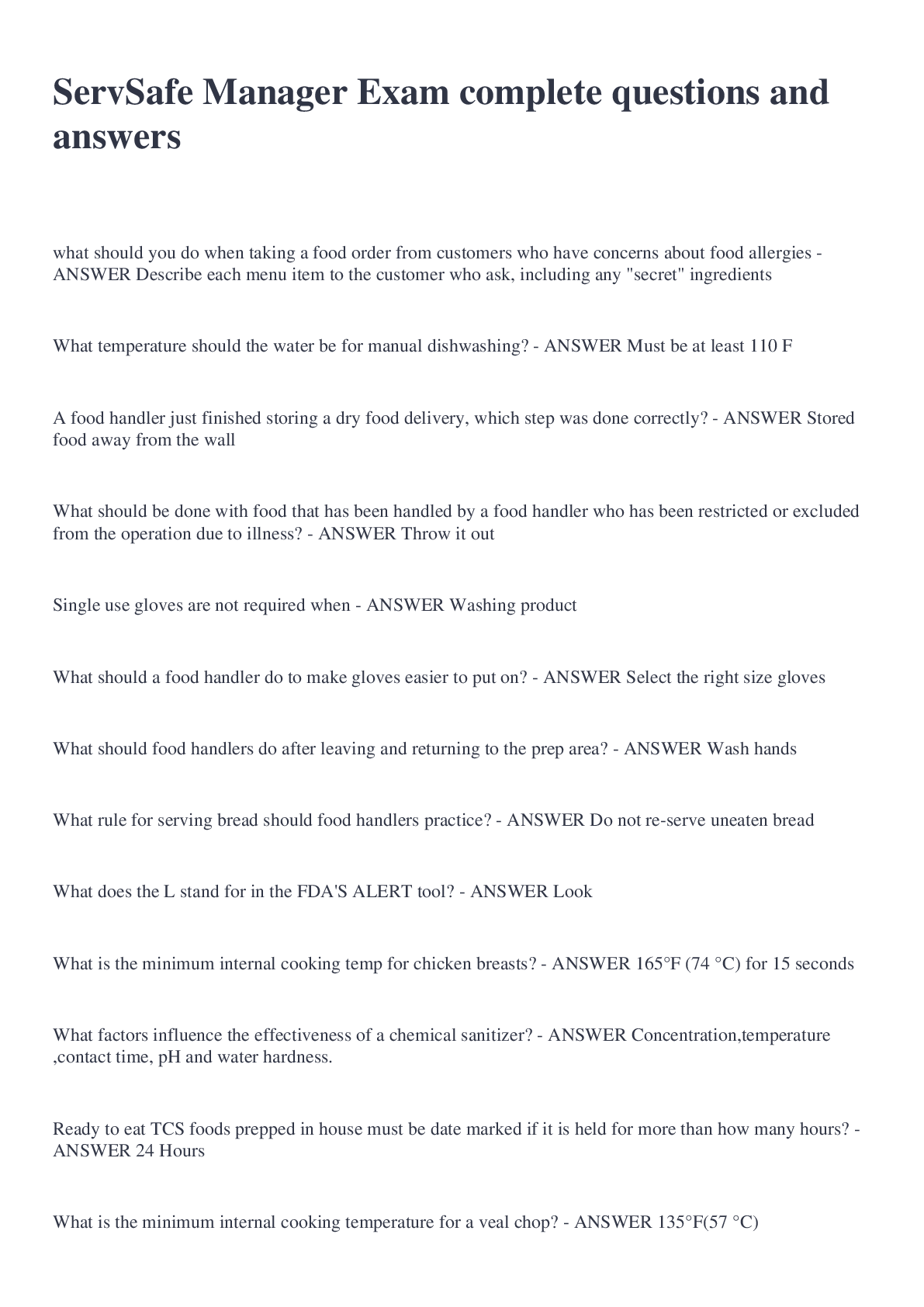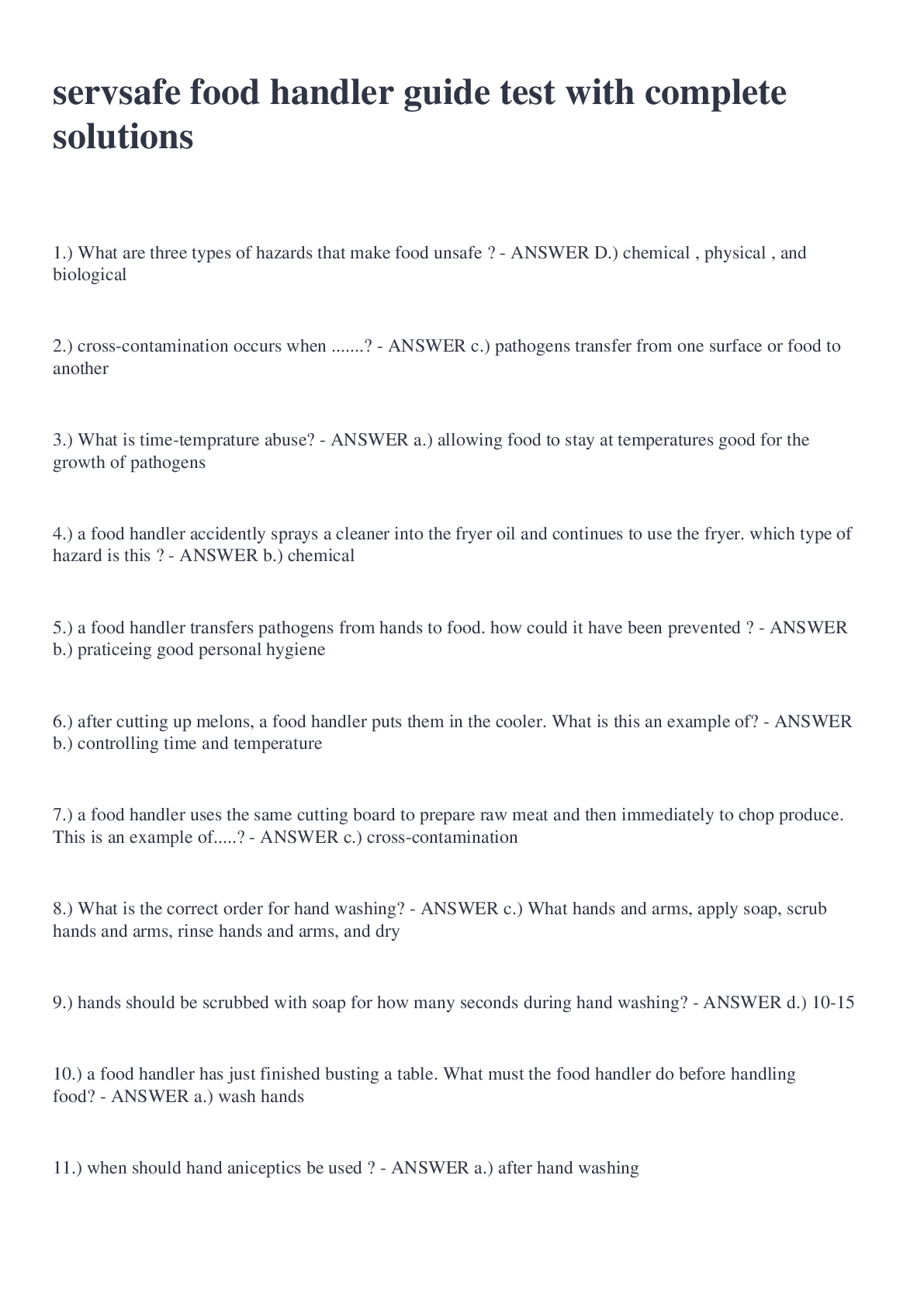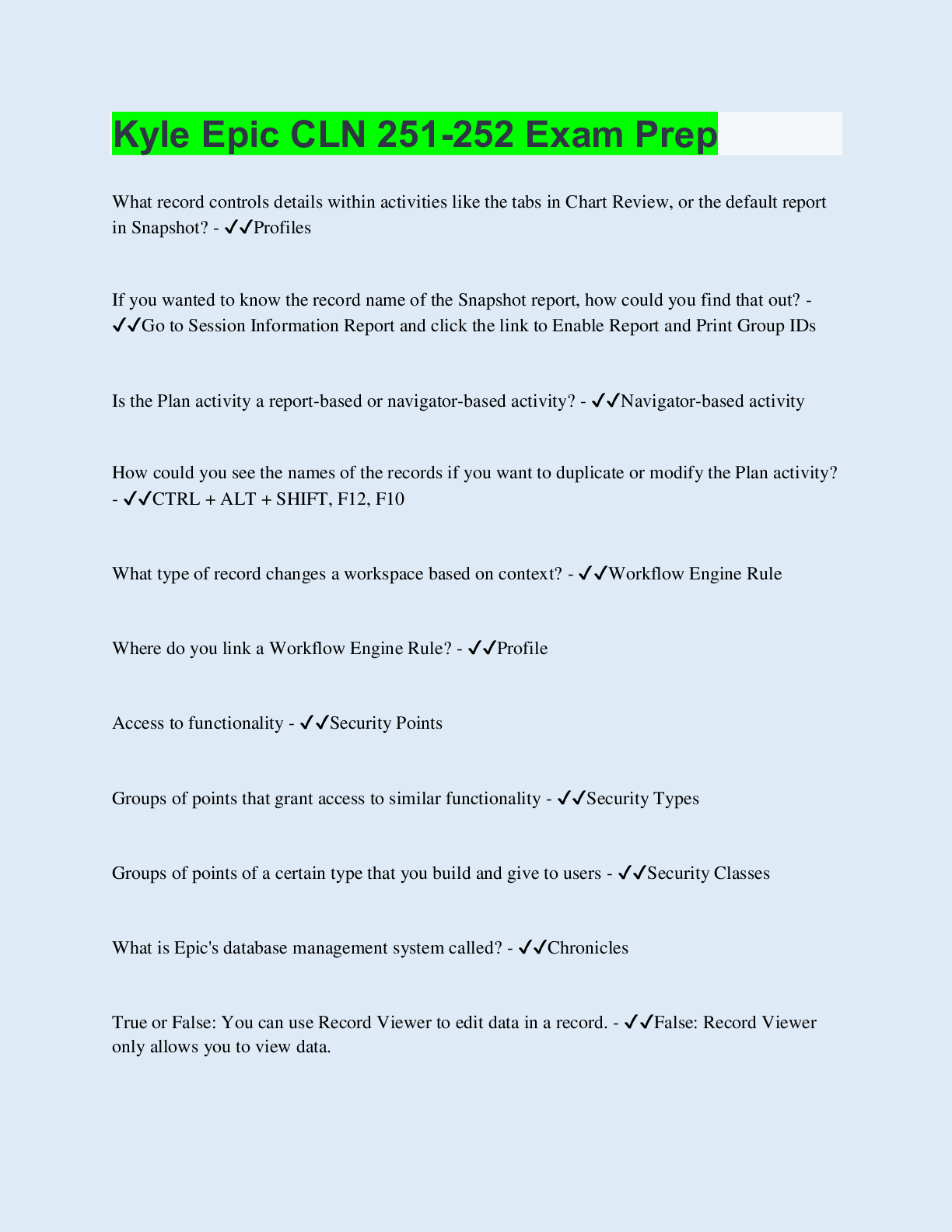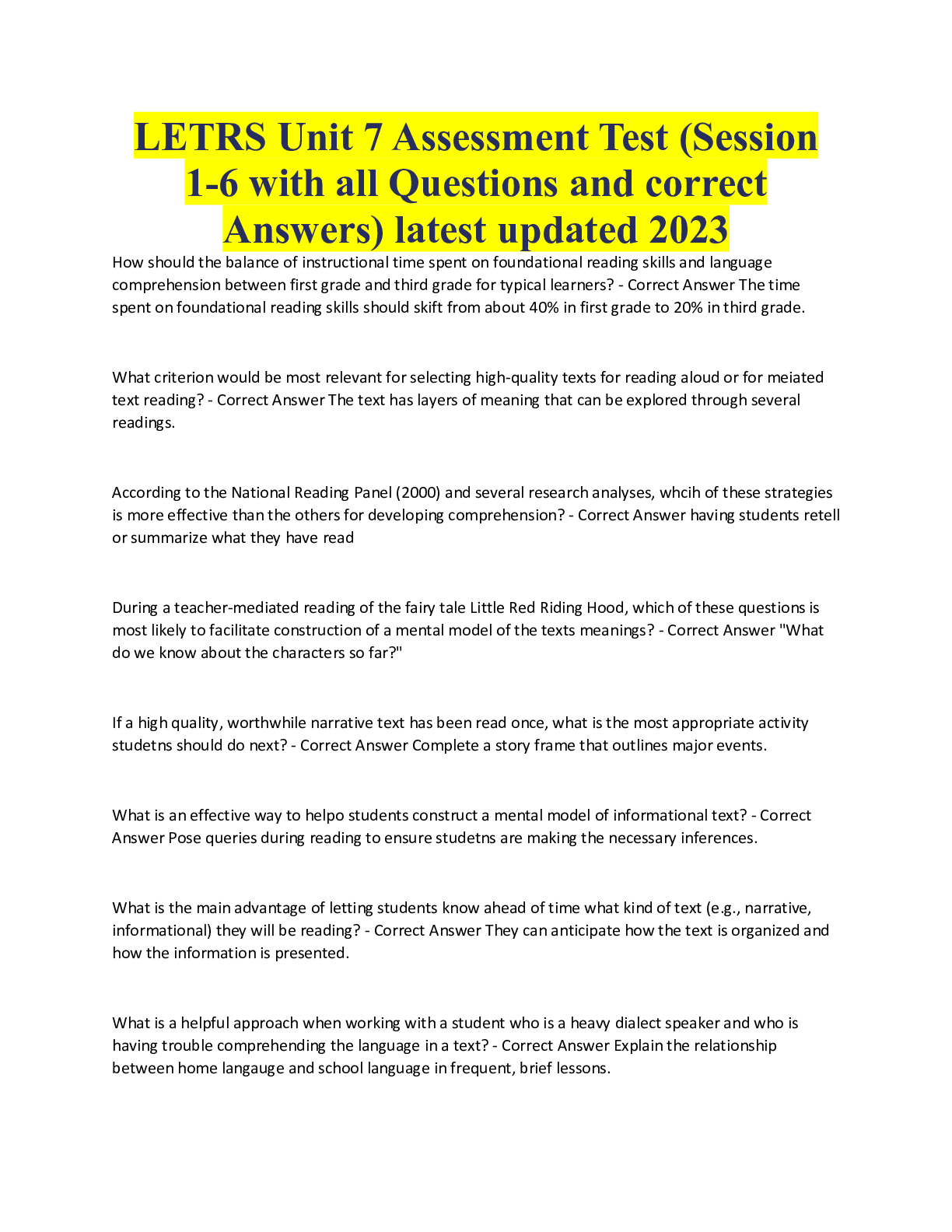Social Sciences > EXAM > IRM Exam 1 Updated Graded A+ (All)
IRM Exam 1 Updated Graded A+
Document Content and Description Below
Accident - ANSWER A sudden, unforeseen, unintended, and unplanned event. Example: The explosion of a steam boiler. Occurrence - ANSWER An event that results in a loss. It includes an accident, but ... is a broader definition because it includes continuous or repeated exposure to harmful conditions that results in property damage. Example: Mold, fungus, or wet rot that results from the accidental discharge or overflow of water or steam within a plumbing, heating, or air conditioning system. Cancellation - ANSWER The termination of an insurance policy before its expiration date. Either the insured or the insurer may cancel the policy. Pro Rata Cancellation - ANSWER The cancellation of a policy for which a refund is made of the unearned premium calculated in proportion to the time the policy was in force. When the insurer cancels the policy, the unearned premium is refunded to the insured on a pro rata basis. Short Rate Cancellation - ANSWER The cancellation of a policy for which the premium refund is calculated according to a short rate table whereby the insurer retains a portion of the unearned premium. When the insured requests cancellation of the policy, the unearned premium is refunded to the insured on a short rate basis. Flat Cancellation - ANSWER The cancellation of a policy on the date the policy becomes effective. This type of cancellation requires the full return of the paid premium. Nonrenewal - ANSWER The termination of an insurance policy after its expiration date by the insurer. Peril - ANSWER A cause of a potential loss. Example: Fire, lightning, wind, hail, etc. Proximate Cause - ANSWER The cause that sets other causes in motion when multiple causes combine to produce loss or damage. The cause without which a given result would have not occurred. Example: A fire that causes a subsequent explosion or smoke damage; without the fire there would not have been a subsequent explosion or smoke damage. Hostile Fire - ANSWER A fire that produces a visible spark, flame, or glow and leaves the area in which it was intended to be kept. Example: A spark jumps from a fireplace and ignites a nearby area rug. Inherent Vice - ANSWER A condition or defect that exists within property itself that causes the property to spoil, break, become defective, or destroy itself. Insurance policies typically exclude inherent vice. Example: The quality of materials used in a painting allows the painting to fade or lose luster with time. Binder - ANSWER A document that temporarily provides insurance coverage until a policy is issued. The binder specifies the perils covered, the amount of coverage, the effective date of the coverage, and the name of the insurer providing the coverage. The binder does not state the premium amount. Arbitration - ANSWER The process whereby a disputed claim is decided by a neutral third party. Arbitration is sometimes used to resolve differences between the insured and insurer. Right of Salvage - ANSWER The right of the insurer to take possession of damaged property after the loss to the property has been paid. The salvage belongs to the insurer. Endorsement - ANSWER A written amendment attached to the policy by the insurer to broaden or restrict coverage, or to further define certain policy provisions. Once attached, the endorsement takes precedence over the original provisions of the policy. An endorsement may also be referred to as a rider. Example: Inflation Guard Endorsement to a Homeowners policy. Concurrent Causation - ANSWER A situation where there are 2 causes resulting in a loss and 1 of the causes is excluded while the other cause is not excluded. Unless the policy specifies otherwise, the loss is covered. Example: A policy that excludes earth movement will still pay a loss due to fire or explosion that ensues directly from the earth movement. Concurrency - ANSWER A situation under which at least 2 policies provide identical coverage for the same risk. When policies are concurrent, each policy pays that proportion of a loss that its limits bear to the total of all policies. Example: A building is covered for a total of $500,000. Company A provides $250,000 of the total, Company B provides $250,000 of the total, and the building sustains a $100,000 covered loss. Company A would pay $50,000 of the loss, and Company B would pay $50,000 of the loss. Nonconcurrency - ANSWER A situation under which at least 2 policies cover an insured's property against damage or destruction, but since the limits of coverage, kinds of property, and perils covered are not the same under all policies, the insured may not be fully covered in the event of a loss. Bailee - ANSWER An individual or organization who has taken into its care, custody, and/or control the property of another for servicing, repair, or storage. Example: Dry cleaners, jewelers, furriers, etc. Bailor - ANSWER An individual who retains the ownership of property that has been taken into the care, custody, and/or control of a bailee. Example: The owner of the clothing to be cleaned, the jewelry to be repaired, or the fur to be stored. Primary Insurance - ANSWER Property coverage that provides benefits up to the limits of a policy, regardless of other policies in effect. Excess Insurance - ANSWER Property coverage above the primary amount of insurance. Excess insurance does not pay until any primary insurance has been exhausted. Example: Primary insurance is $250,000, and the excess insurance is $1,000,000. After the losses exceed $250,000, the excess insurance will pay for the losses up to a total of $1,000,000. Unoccupancy - ANSWER A property that contains personal property or contents but has no occupants is described as unoccupied. Vacancy - ANSWER A property that has neither occupants nor personal property is described as vacant. Direct Loss - ANSWER Damage to property in which the proximate cause of the loss is an insured peril. Example: Fire damage to an insured residence, or water damage to the residence resulting from a ruptured water pipe. Indirect Loss (Consequential/Contingent Loss) - ANSWER A second or financial loss occurring as the result of a direct loss. Example: Additional living expenses incurred as the result of a private residence being rendered uninhabitable as the result of a fire or other type of direct loss; loss of rental income caused by a direct loss; loss of business income and extra expenses caused by a direct loss. Named Peril - ANSWER Coverage applies only to losses caused by perils that are specifically stated in the policy. Example: Fire, lightning, wind, hail, aircraft, riot, vehicles, explosion, smoke, etc. Open Peril (Special Form) - ANSWER Coverage applies to all losses caused by all perils except for those specifically excluded. Open peril coverage is sometimes referred to as all risk coverage. Example: Some of the perils typically excluded are earth movement, ordinance or law, power failure, nuclear hazard, etc. Actual Cash Value (ACV) - ANSWER The policy pays for the cost to repair or replace the damaged property at the time of loss, less depreciation. Stated another way, the policy pays current replacement cost less depreciation. Example: A building has a roof with a 20-year life expectancy destroyed by hail 5 years after its installation, and the cost to replace the roof at the time of the loss is $10,000. The current replacement value of $10,000, less depreciation of $2,500 (25 percent), equals the actual cash value of $7,500 Replacement Cost - ANSWER The policy pays the full cost to replace or repair the damaged property (not exceeding policy limits) at the time of the loss without an adjustment for depreciation. Note #1: The Replacement Cost method of loss valuation requires that the coverage amount at the time of the loss be at least equal to 80 percent of the cost of replacement. Note #2: The Replacement Cost method of valuation requires repair or replacement to the damaged property with like kind and quality of material Functional Replacement Cost - ANSWER A property policy provision that changes the valuation method otherwise applicable (Actual Cash Value or Replacement Cost) to valuation that allows replacement with less costly property that is functionally equivalent. Example: The replacement of damaged property with identical property is impossible due to some technological or environmental change. Market Value - ANSWER A property policy provision that changes the valuation method otherwise applicable (Actual Cash Value or Replacement Cost) to a valuation method that allows reimbursement to the insured for damaged property according to the price a willing buyer would pay for the property purchased from a willing seller. Example: Goods and commodities whose value fluctuates with market conditions; namely agricultural products. Agreed Value - ANSWER An option for property policies insuring various classes of property whose actual value or replacement cost is difficult to determine. The insured and insurer agree, at the time of insuring, on an amount of insurance to be paid in the event of a loss. Example: Fine arts and antiques are classes of property insured on an agreed value basis. Stated Amount - ANSWER An amendment to the valuation method of a property insurance policy insuring an unusual or valuable piece of property that establishes, at the time of insuring, a maximum amount of insurance to be paid in the event of a loss. Example: Antique and classic automobiles are types of property insured on a stated amount basis Valued Policy - ANSWER Many states have passed legislation known as a Valued Policy Law that requires an insurer to pay the full amount of insurance on an insured structure in the event of a total loss. Example: A building that is insured for $500,000 sustains what is determined to be a total loss as the result of a fire. The insurer pays the full $500,000 regardless of the value of the building at the time of loss. Specific Coverage - ANSWER This method of writing coverage is used when insuring 1 property on 1 policy for 1 specific amount of insurance. Scheduled Coverage - ANSWER This method of writing coverage is used when insuring more than 1 property on 1 policy with a specific amount of insurance on each property Blanket Coverage - ANSWER This method of writing coverage is used when insuring more than 1 property on 1 policy for a single amount of insurance that applies to all properties covered under the policy. The amount of insurance must equal at least 90 percent of the value of all of the properties insured. Example: Commonly used to insure business personal property or contents at multiple locations with no specific limit per location. Fire Resistive - ANSWER The materials that are used in the walls, floors, and roof of a structure must resist damage from fire for not less than 2 hours. Approved masonry or reinforced concrete must be used for exterior and interior bearing walls. Modified Fire Resistive - ANSWER The materials that are used in the walls, floors, and roof of a structure must resist damage from fire for at least 1 hour, but less than 2 hours Masonry Noncombustible - ANSWER The exterior walls must be of masonry material with the floor and roof of metal or other noncombustible materials Noncombustible - ANSWER The materials that are used in the exterior walls, floor, and supports must be made of metal, asbestos, gypsum, or other noncombustible materials Joisted Masonry - ANSWER The exterior walls must be of masonry material with the floor and roof of combustible material Mill or Heavy Timber - ANSWER A type of joisted masonry construction characterized by heavy timber girders and columns with flat smooth surfaces running the length of the building with few corners. Frame - ANSWER A structure with walls and interior structural components made of wood or other combustible materials. Declarations - ANSWER The Declarations Page of the policy contains basic information about the policy including: 1. Who - Names the insurer and insured, including legal representatives in the event of the insured's death. 2. What - A description of the property being insured. 3. Where - The address or legal description of the property being insured. 4. When - The effective and expiration dates of the policy. 5. How Much - The limits of insurance coverage, the deductible, and how much premium. Insuring Agreement or Clause - ANSWER The Insuring Agreement or Clause states that the insurer will indemnify the insured for a covered loss. It is the insurer's promise of protection to the insured. A description of the covered causes of loss (perils), that determines the coverage provided, is contained therein. Additional/Supplementary Coverages - ANSWER Coverage for incidental expenses that frequently occur in connection with causes of loss (perils) stated in the policy. Example: Debris removal, Fire Department Service Charge, Property Removed, etc. Conditions - ANSWER The portion of the policy that sets forth the rights, rules, duties, and obligations of the insurer and insured to follow throughout the policy period. These conditions include: Death - ANSWER Specifies that in the event of death of the insured named on the Declarations Page of the policy, the insurer will insure the legal representative of the deceased, but only with respect to the premises and property of the deceased covered under the policy at the time of death. Bankruptcy Clause - ANSWER Specifies that bankruptcy or insolvency of the insured does not relieve the insurer of any of its duties or obligations under the policy. Recovered Property - ANSWER Specifies the procedure to be followed if the insured or insurer should recover any property for which the insurer has made payment under the policy. Each party shall notify the other of any recovery, and at the insured's option the property will be returned to or retained by the insured or it will become the insurer's property. If the recovered property is returned to or retained by the insured, the loss payment will be adjusted based upon the amount the insured received for the recovered property No Benefit to Bailee - ANSWER Specifies that the insurer will not recognize any assignment or grant any coverage that benefits a person or organization holding, storing, or moving the insured property for a fee. Please see the definition of bailee discussed earlier in this chapter. Standard Mortgage Clause (a.k.a. Mortgage Clause) - ANSWER Specifies and protects the mortgagee's (lender's) financial interests in property insured by the policy. The mortgagee must perform certain duties to protect its interests, which include: a. Paying any premium due under the policy on demand if the insured fails to do so. b. Notifying the insurer of any change in ownership, occupancy, or substantial change in risk of which the mortgagee is aware. c. Submitting a signed, sworn statement of loss within 60 days after receiving notice from the insurer of the insured's failure to do so. Note #1: If the insurer denies a claim because the insured has failed to comply with the terms of the policy, the mortgagee will still have the right to loss payment if the mortgagee complies with the above duties. Note #2: If the insurer cancels the policy for nonpayment of premium, the insurer must give the mortgagee at least 10 days written notice before the effective date of cancellation. If the insurer decides not to renew the policy, the insurer must give the mortgagee written notice at least 10 days before the nonrenewal takes effect. Note #3: If the insurer fails to notify the mortgagee in the event of cancellation or nonrenewal and a loss should occur, the insurer must indemnify the mortgagee for the mortgagee's financial interest in the loss. Abandonment of Property - ANSWER Specifies that the insured may not abandon or relinquish ownership of damaged property to the insurer for disposal or repair. Loss Payment - ANSWER Specifies the time frame within which the insurer must pay a loss to the insured after the insurer has received the insured's proof of loss and reached an agreement with the insured. Legal Action Against Us - ANSWER Specifies that the insured may not bring suit against the insurer until the insured has complied with all of the terms of the policy Other Insurance (a.k.a. Apportionment or Pro Rata Liability) - ANSWER Specifies the process to be followed when more than 1 policy covers the same loss. Each policy pays no more than its share of the loss. Example: Policy A is written for $200,000, Policy B for $300,000, and Policy C for $500,000 on a building. The building sustains a loss in the amount of $100,000 that is covered by all 3 policies. Policy A represents 20 percent of the total amount of coverage and therefore would pay $20,000 of the loss. Policy B represents 30 percent of the total amount of coverage and therefore would pay $30,000. Policy C represents 50 percent of the total amount of coverage and therefore would pay $50,000. Appraisal - ANSWER Specifies that if the insured and insurer cannot agree on the amount of a loss, either may demand an appraisal. If demanded, the insured and the insurer will each select an appraiser, who then jointly select an umpire. The appraisers will appraise the loss and either agree or submit their differences to the umpire. An agreement by any 2 of the 3 parties is binding, and each party will pay the cost of its own appraiser and share equally the cost of the umpire. Claim Settlement - ANSWER Specifies the valuation method(s) used to pay losses. Please see Loss Valuation discussed earlier in this chapter. Your Duties in the Event of Loss (Notice of Loss) - ANSWER Specifies the obligations of the insured in the event of a loss under the policy. These obligations include: a. Giving prompt notice of the loss to the insurer. b. Notifying the police if a law has been broken. c. Cooperating with the insurer in the investigation of the loss. d. Forwarding any demands regarding the loss to the insurer. e. Protecting the damaged property from further loss and separating damaged property from undamaged property. f. Preparing an inventory of the damaged property. g. Submitting proof of loss to the insurer, including: 1) The time and cause of loss. 2) Any other insurance that may cover the loss. 3) Any appropriate receipts, evidence, or affidavits to support the loss. Restoration/Nonreduction of Limits - ANSWER Specifies the sum and circumstances under which an insurer charges the insured, usually a business firm, to restore a policy to its initial face value or not reduce limits of coverage after the insurer has paid a claim either to the insured business or a third party on behalf of the business. Insurable Interest and Limit of Liability - ANSWER Specifies that the insurer will not be responsible for an amount which is greater than the financial interest of an insured person or more than the limit of liability stated on the Declarations Page of the policy. Changes - ANSWER Specifies that any changes to the policy must be made by the insurer's written endorsement. Subrogation - ANSWER The legal process by which an insurer seeks recovery of the amount paid to the insured from a third party responsible for having caused the loss. Subrogation transfers an insured's legal right of recovery to the insurer that has paid a claim, and also: a. Prevents the insured from collecting twice for the same loss. b. Helps the insurer maintain lower insurance rates. c. Ultimately holds the responsible third party accountable for the loss. Example: If an insured's neighbor is responsible for burning down the insured's garage, once the insured's insurance policy pays the loss, the insurer subrogates the loss against the neighbor. Assignment - ANSWER Specifies that the insured may not transfer rights of ownership or interests in an insurance policy to another party without the insurer's written consent. Nonrenewal - ANSWER The insurer may elect to nonrenew the policy, after its expiration date, by giving to the named insured 30 days written notice. The reason for the nonrenewal must be clear and specific. Note #1: The number of days notice mentioned above might vary in some states. If your state has any unique legislation regarding nonrenewal, it will be discussed in Chapter 20. Note #2: Proof of mailing of the Notice of Nonrenewal will be sufficient proof of notice. Cancellation - ANSWER The following provisions apply: a. The named insured may cancel the policy at any time by giving written notice to the insurer. [Show More]
Last updated: 2 years ago
Preview 1 out of 55 pages

Buy this document to get the full access instantly
Instant Download Access after purchase
Buy NowInstant download
We Accept:

Reviews( 0 )
$10.00
Can't find what you want? Try our AI powered Search
Document information
Connected school, study & course
About the document
Uploaded On
Oct 07, 2022
Number of pages
55
Written in
Additional information
This document has been written for:
Uploaded
Oct 07, 2022
Downloads
0
Views
48

